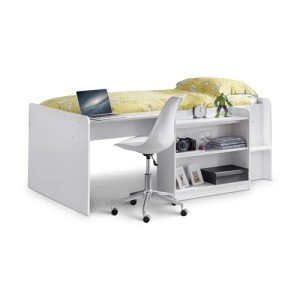Bunk Beds for Kids: A Comprehensive Guide
Bunk beds have been a popular choice for children's bed rooms for years. They use a space-saving solution that makes the most of floor area, provides enjoyable climbing choices, and is available in a range of designs that interest children's imaginations. This post checks out the advantages, factors to consider, styles, and security features associated with bunk beds for kids.
Benefits of Bunk Beds
Bunk beds present multiple benefits that make them an attractive choice for families. Here are some key advantages:
Space Saving
- Bunk beds enable 2 or more children to share a space without sacrificing space for play or other activities.
Economical
- Getting a single bunk bed can be more economical than purchasing 2 separate beds.
Fun Factor
- Kids often see bunk beds as a fun location to sleep and play, cultivating a sense of adventure.
Versatility
- Bunk beds are offered in various setups, consisting of L-shaped, loft beds, and even convertible styles that can change as children grow.
Organization
- Many bunk beds include integrated storage alternatives, such as shelves and drawers, assisting keep rooms arranged.
Key Considerations Before Purchasing
Before investing in a bunk bed, it's important to think about specific elements, such as:
- Space Requirements
Step the room to make sure that there suffices vertical space, allowing for sufficient headroom on the leading bunk. - Age of Your Children
Consider their age and maturity. Many producers recommend that kids under 6 ought to not oversleep the leading bunk due to security issues. - Weight Limit
It's important to examine the weight limits of the bunk bed for both the top and bottom bunks to ensure security. - Style Preferences
Pick a design that matches the space's design and the children's choices. - Product
Bunk beds are offered in different products, such as wood or metal. Each has its advantages and disadvantages concerning resilience and visual appeals.
Styles of Bunk Beds
Bunk beds come in various designs to fit various aesthetics and practical needs. Here's a list of some popular designs:
- Standard Bunk Beds
Timeless stacked beds that consist of two beds constructed one above the other. - Loft Beds
A bed raised high off the ground, with space underneath for a desk, play area, or storage. - L-Shaped Bunk Beds
2 beds arranged in an L-shape, supplying more flooring space and a distinct style element. - Twin Over Full Bunk Beds
These alternatives include a twin bed on the top and a full-sized bed on the bottom, accommodating older kids or adults. - Triple Bunk Beds
Developed for three children, these beds usually include three stacked beds, perfect for larger households.
Safety Features to Consider
Guaranteeing the safety of children using bunk beds is paramount. Here are some security includes to search for before making a purchase:
- Guardrails
A bunk bed should consist of strong guardrails on the top bunk to avoid unexpected falls. - Ladders
Guarantee that the ladder is securely connected and simple for children to navigate safely. - Stability
Look for bunk beds with lower centers of gravity and wide bases to offer better stability. - Quality Construction
Select beds made from durable materials that fulfill security standards, such as ASTM (American Society for Testing and Materials) policies.
FAQs About Bunk Beds
1. What age is suitable for a leading bunk?Generally, kids aged six and older are suggested for sleeping in the top bunk. 2. Are bunk beds safe for toddlers?Most experts recommend versus
positioning young children in the top bunk due to the
danger of falls and improper ladder use. 3. Can bunk beds be separated?Many bunk beds are designed to be separated into two standalone beds,
providing included versatility as children grow
. 4. How do I preserve a bunk bed?Regularly check for loose screws and use, keep mattresses clean, and guarantee that the bunk bed is
stable to prolong its lifespan. 5.
Are there any unique mattress requirements for bunk beds?Yes, mattresses for bunk beds need to fit snugly without leaving gaps. Typically, thinner bed mattress
(around 6 to 8 inches )are suggested for leading bunks for security. Bunk beds provide a flexible, practical, and fun service for kids's sleeping arrangements, maximizing space while accommodating several kids in one space. By thinking about the important aspects
of design, safety, and space, moms and dads can make an informed decision when choosing the right bunk bed for their kids's requirements. With Bunk Beds House and maintenance, a bunk bed can be a precious piece of furnishings that offers years of use and satisfaction for kids. Summary Table of Bunk Bed Styles Style Description Best For Standard Bunk Beds Classic design, 2 stacked beds Smaller sized rooms Loft Beds Raised bed with open space beneath Research study or play areas L-Shaped Bunk Beds Two beds in an L-shape
Added floor space Twin Over Full Twin on top,
| full on bottom Accommodating older children Triple | ||||||
|---|---|---|---|---|---|---|
| Bunk Beds | Three stacked beds | Bigger households By understanding | the different options available, designated factors to consider for security and functionality, and suitable age guidelines, families | can choose the perfect bunk bed that not | only improves their living space | however likewise makes sure a safe and |
| enjoyable sleeping environment | for their children.

|
